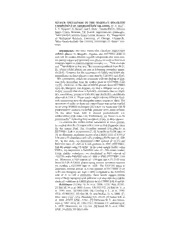
NASA Technical Reports Server (NTRS) 20090020654: Sulfur Speciation in the Martian Regolith Component in Shergottite Glasses PDF
Preview NASA Technical Reports Server (NTRS) 20090020654: Sulfur Speciation in the Martian Regolith Component in Shergottite Glasses
SULFUR SPECIATION IN THE MARTIAN REGOLITH COMPONENT IN SHERGOTTITE GLASSES. M. N. Rao1 , L. E. Nyquist2, S. Sutton3, and J. Huth4. 1Jacobs-ESCG, Johnson Space Center, Houston. TX. E-mail: nageswara.rao @nasa.gov. 2ARES,NASA,Johnson Space Center, Houston. TX. 3Department of Geological Sciences, University of Chicago, Chicago.IL. 4Max-Planck-Institute fuer Chemie, Saarstrasse 23, Mainz. Ger- many. Introduction: We have shown that Gas-Rich Impact-Melt (GRIM) glasses in Shergotty, Zagami, and EET79001 (Lith A and Lith B) contain Martian regolith components that were mol- ten during impact and quenched into glasses in voids of host rock materials based on neutron-capture isotopes, i.e., 150Sm excesses and 149Sm deficits in Sm, and 80Kr excesses produced from Br [1, 2]. These GRIM glasses are rich in S-bearing secondary miner- als [3.4]. Evidence for the occurrence of CaSO and S-rich alu- 4 minosilicates in these glasses is provided by CaO-SO and Al O 3 2 3 – SO correlations, which are consistent with the finding of gyp- 3 sum laths protruding from the molten glass in EET79001 (Lith A) [5]. However, in the case of GRIM glasses from EET79001 (Lith B), Shergotty and Zagami, we find a different set of sec- ondary minerals that show a FeO-SO correlation (but no MgO- 3 SO correlation), instead of CaO-SO and Al O-SO correlations 3 3 2 3 3 observed in Lith A. These results might indicate different fluid- rock interactions near the shergottite source region on Mars. The speciation of sulfur in these salt assemblages was earlier studied by us using XANES techniques [6], where we found that Lith B predominantly contains Fe-sulfide globules (with some sulfate). On the other hand, Lith A showed predominantly Ca- sulfite/sulfate with some FeS. Furthermore, we found Fe to be present as Fe2+ indicating little oxidation, if any, in these glasses. To examine the sulfide-sulfate association in these glasses, we studied their Fe /Ni ratios with a view to find diagnostic clues for the source fluid. The Fe-sulfide mineral (Fe Ni S) in 0.93 0.3 EET79001, Lith A is pyrrhotite [7, 8]. It yields an Fe/Ni ratio of 31. In Shergotty, pyrrhotite occurs with a molar ratio of Fe:S of 0.94 and a Ni abundance of 0.12% yielding a Fe/Ni ratio of ~500 [8]. In this study, we determined a NiO content of ~0.1% and FeO/NiO ratio of ~420 in S-rich globules in #507 (EET79001, Lith B) sample using FE-SEM. In the same sample (bulk), using EMPA, we determined a FeO/NiO ratio of ~700 (raster mode). Using similar techniques, we determined a NiO content of ~0.015% and a FeO/NiO ratio of ~800 in #506 (EET79001, Lith A). Moreover, a NiO content of ~150 ppm and 6.1% FeO were found in Lith A GRIM glasses using neutron activation analysis [9] yielding a FeO/NiO ratio of ~420. The FeO/NiO ratios in secondary mineral phases in S-rich pockets of EET79001 (Lith A/B) and Shergotty are high (~400) compared to the FeO/NiO ratio of 31 in Lith A pyrrhotite. These results suggest similar kind of fluids interacted with different rock materials to yield the observed variations in GRIM glasses in EET79001 Lith A and B. References: [1] Rao M. N. et al. 2008. LPSC 40th, #1361. [2] Rao M. N. et al. 2002. Icarus, 156:352-372. [3] Rao M. N. et al. 1999. GRL, 26:3265-3268. [4] Gooding J. L. et al. 1988. GCA, 52:909-915. [5] Rao M. N. and McKay D. S. 2003. 6th, Inter. Mars Conf. J.P.L. Pasadena, CA. #3130. [6] Sutton S.R. et al. 2008, XXXIX LPSC, #1961. [7] McSween H. Y. and Jarose- wich E. 1983. GCA, 47: 1501-1513. [8] Smith J.V. and Hervig R. L. 1979. Meteoritics, 14: 121-142. [9] Smith M. R. et al. 1984. LPSC 14 (JGR), 89: B612-630.
